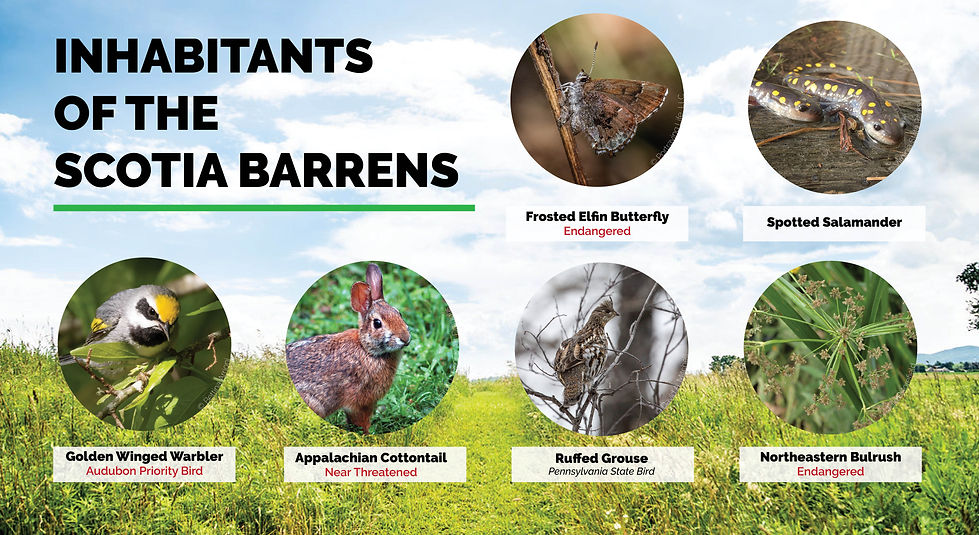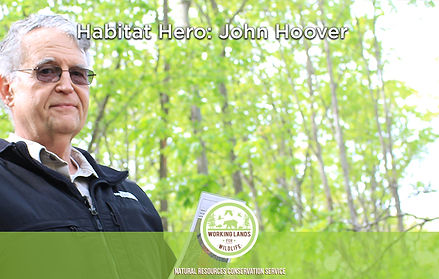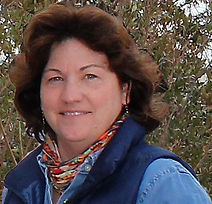
SCOTIA BARRENS
CONSERVATION PROJECT
PAST EVENTS
Just west of State College lies one of Pennsylvania’s unique natural wonders...The Scotia Barrens.
This rare habitat is one of the largest examples of pitch pine-scrub oak barrens remaining in our state—making it an extraordinary home for a wide variety of wildlife, a primary source of groundwater, and a place to teach the next generation about the natural world.
As a destination for outdoor recreation, the miles of trails cater to hikers and mountain bikers, while the Barrens' ability to support wildlife draws both birdwatchers and sportsman.
This unique habitat, as well as the barrens' geographic proximity to State College, make it one of the most frequented outdoor recreation areas in the region.
Scotia is also the site of ClearWater led educational excursions including a trip to the area’s vernal pools (temporary ponds) - crucial breeding grounds for amphibious species like salamanders and frogs, as well as a guided hike through the wildlife corridor that connects the Scotia Barrens to the Bald Eagle Ridge.
We work to connect, protect, restore, and steward natural wonders like Scotia Barrens through programs like the Scotia Barrens Young Forest Initiative– a collaboration of landowners and natural resource professionals committed to restoring the disappearing habitat along with the many declining wildlife species that depend on it.
By introducing landowners to environmental best practices, we are creating stewards dedicated to the preservation of treasured locations like the Barrens.


The Scotia Barrens Young Forest Initiative (SYFI) is about more than just young forests.
It's about:
-
Fostering stewardship across boundaries by identifying a common purpose.
-
Promoting recognition of shared landscapes and the need for action.
-
Creating a comprehensive plan for strategic land and water conservation to connect, protect, restore, and steward important and critical landscapes in the Upper Spruce Creek Watershed.
The desired result will be a connected network of high-quality natural habitats and ecosystems to support diverse, abundant and viable populations and communities.
The overall goal of the initiative is to create a comprehensive plan. Rather than approach conservation projects like darts thrown randomly at a dart board, we hope to create a connected network of high-quality habitats and eco-systems to support diverse, abundant, and viable populations and communities.
What is most important to you about your woodlands, fields, and streams?
What kind of activities have you done or would you like to do on your land? What kind of challenges do you face when caring for your land? How about your neighbors?
This plan includes strategies to overcome many of the common barriers we often face when attempting to get conservation projects off the ground. For the landowner, this may include:
-
"Where do I start?"
-
"Who do I contact for information or help?"
-
"Where will I find the resources to get the job done? "
Often, technical service providers cover large regions and are short-handed, allowing little to no time for initial consultations. You might simply desire more information without being pressured to sign up for programs you may not want or need.
That's where we come in...
The SYFI is not about pressuring folks into actions that oppose their goals and priorities for their lands. By providing a forum for landowners to ask questions, voice their concerns, and learn more about available options, the SYFI is designed to make the process easier for everyone.
Many landowners don't realize how important different habitats, especially young forests, are for wildlife or the fact that there are so many opportunities they can take advantage of to create these important habitats.
Strategies:
-
Restore degraded wildlife habitats
-
Improve forest age structure and biodiversity
-
Connect important natural areas (e.g. the Scotia Barrens) to large blocks of natural habitat, including the forested ridges.
-
Improve water quality by reducing pollution.
-
Restore degraded stream, wetland, and riparian habitats
-
Maintain existing water quality of high integrity areas
-
Establish continuous forest buffers along stream corridors and throughout stream networks.
-
Ensure long- term protection of these areas from existing and future threats through land conservation.
Today's the day! Reach out for tailored solutions... We'll listen and do our best to help you find the solutions you need to make the most of your woodlands, fields, wetlands, streams, and other natural areas.
ADDITIONAL RESOURCES
Want to learn more about the importance of young forests? Download this presentation from Tammy Colt, Pennsylvania Game Commission Wildlife Diversity Biologist to learn more!
Habitat Hero: John Hoover

Since 1866 – a year after the end of the Civil War – John Hoover’s family has owned property in Centre County, Pennsylvania. Over the decades, the largely forested property became subdivided and boundary lines and titles blurred with most of the land going into disuse. Nearly 40 years ago, when John inherited a portion of the original property, he figured the best way to unclutter boundary lines and make better use of the land was to buy as much of the surrounding forest and original deed as possible.
“I’m a mechanical engineer and mostly dealt in new product design and development,” said Hoover. “And this land issue was a challenge, a unique problem that I wanted to solve. It took me more than a dozen years but I ended up bringing together 600 acres under single ownership.”
Hoover currently lives in Connecticut but plans to retire soon and relocate to a home next to his forest.
The land is situated in a corridor that connects the 5,900-acre Bald Eagle State Park with 4,000 acres of State Game Lands. Its location makes it a potentially valuable commodity as a linkage for wildlife and natural resources, a vital connector between two protected areas.
“Something that occurred to me after I acquired all this land, is that I didn’t really have a goal in mind for the property itself,” said Hoover. “So, I talked with a forester, and he told me about the benefits of harvesting trees for the health of the forest and as a way to enhance game species such as deer, turkey and grouse.”
The first harvest, which cut and thinned out aspen trees, saw a dramatic increase in game species on the land. Six more harvests followed. Each targeted at a specific section of the property.
Each successful harvest helped his bottom line by selling timber while diversifying both his forest and the species of wildlife that visited it.
VIRTUAL FOREST TOURS
These Virtual Tours provided by http://amjv.org were created to showcase various forest management techniques like shelterwood harvest, overstory removal, and herbicide use.

